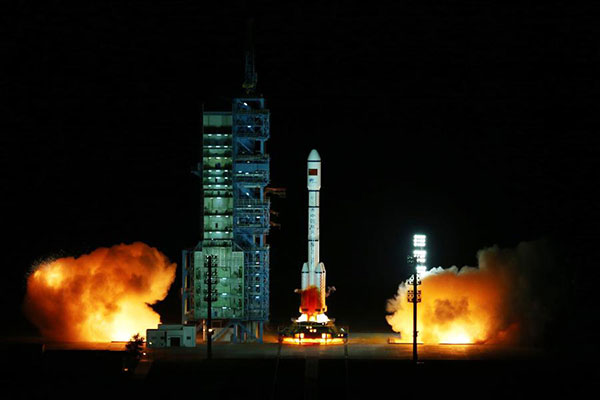

New space lab will be equipped with Bluetooth, better lighting, sound dampening, exercise equipment and other features
China's newest space laboratory, Tiangong II, will provide more comfortable digs to astronauts living aboard than its predecessor, Tiangong I, the spacecraft's designers said.
Zhu Zongpeng, chief designer of Tiangong II at China Academy of Space Technology, said designers aimed to create an astronaut-friendly environment in every regard when they refitted the space lab that was developed based on Tiangong I.
"We considered many factors including the sound, lighting, inner decorations as well as support facilities. For instance, we installed a foldable, multifunctional table that can be used for dining and experiments. We also equipped the astronauts with Bluetooth headsets and Bluetooth speakers," he said.
"A number of particulars were taken into account-the carpet in Tiangong I was replaced with floorboards. The light is softer and its brightness can be adjusted. Each astronaut has a bed lamp," Zhu added.

The Tiangong II consists of two cabins with separate functions-the experiment cabin will be hermetically sealed and will act as the astronauts' living quarters, while the resource cabin will contain solar panels, storage batteries, propellant and engines.
Liao Jianlin, a senior engineer at the academy who took part in Tiangong II's development, said the lab has about 15 square meters for astronauts to live and work, including a separate sleep section and waste storage area.
He said engineers installed muffler devices in the spacecraft to ensure its inner sound is kept under 50 decibels. Environmental controls will keep the temperature within the experiment cabin between 22 C and 24 C and the humidity between 45 and 55 percent.

In addition, Tiangong II has an air detector capable of checking for and dealing with more than 20 hazardous gases and microbes.
Furthermore, designers placed exercise equipment in the space lab such as a treadmill, exercise bike and acupuncture point massager to help astronauts keep healthy, according to Liao.
He said its communications systems also allow astronauts to receive and reply to emails and make calls to family and friends.
 Fire brigade in Shanghai holds group wedding
Fire brigade in Shanghai holds group wedding Tourists enjoy ice sculptures in Datan Town, north China
Tourists enjoy ice sculptures in Datan Town, north China Sunset scenery of Dayan Pagoda in Xi'an
Sunset scenery of Dayan Pagoda in Xi'an Tourists have fun at scenic spot in Nanlong Town, NW China
Tourists have fun at scenic spot in Nanlong Town, NW China Harbin attracts tourists by making best use of ice in winter
Harbin attracts tourists by making best use of ice in winter In pics: FIS Alpine Ski Women's World Cup Slalom
In pics: FIS Alpine Ski Women's World Cup Slalom Black-necked cranes rest at reservoir in Lhunzhub County, Lhasa
Black-necked cranes rest at reservoir in Lhunzhub County, Lhasa China's FAST telescope will be available to foreign scientists in April
China's FAST telescope will be available to foreign scientists in April "She power" plays indispensable role in poverty alleviation
"She power" plays indispensable role in poverty alleviation Top 10 world news events of People's Daily in 2020
Top 10 world news events of People's Daily in 2020 Top 10 China news events of People's Daily in 2020
Top 10 China news events of People's Daily in 2020 Top 10 media buzzwords of 2020
Top 10 media buzzwords of 2020 Year-ender:10 major tourism stories of 2020
Year-ender:10 major tourism stories of 2020 No interference in Venezuelan issues
No interference in Venezuelan issues
 Biz prepares for trade spat
Biz prepares for trade spat
 Broadcasting Continent
Broadcasting Continent Australia wins Chinese CEOs as US loses
Australia wins Chinese CEOs as US loses